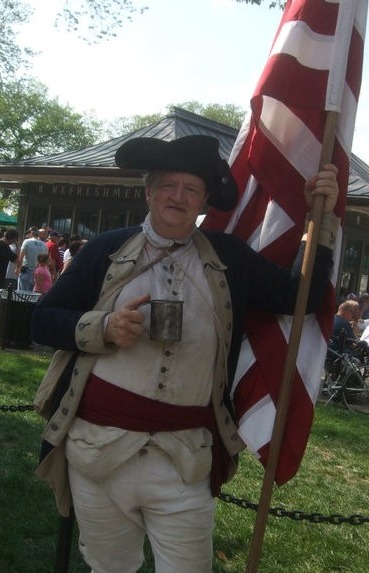
What is nationalism? In
Part 1 I concurred with National Review correspondent
Michael Brendan Dougherty, who believes “nationalism is patriotism in its irritated state”. When examining nationalism we must first recognize we’re dealing with less of a cohesive worldview than a group reaction to a perceived threat. Reactions are neither good nor bad in and of themselves. The only real way to judge a reaction is to examine the circumstances surrounding the reaction. There certainly are problematic examples of nationalism on full display today, but we’ll get to all that later in the series. For now, let’s talk about what a conservative might find commendable about nationalistic reactions.
The Oil Capital of the World
In the evenings—right after work—I enjoy running. And though Tulsa, Oklahoma—the city I call home—offers a wide variety of jogging trails, I prefer running along the city streets. You can learn a lot about a city by running past businesses, cemeteries, and neighborhoods that you’d never notice traveling at high speeds inside your car. You can really get a feel for the city.
Running after work from my office downtown places me in the heart of the city. Just a mile North of the office is a small park with a long name—
The John Hope Franklin Center for Reconciliation. The park was erected as a symbol of hope and reconciliation from one of the most tragic events in the city’s history: The
Tulsa Race Riots. Shortly after World War I, Tulsa became home to one of the most affluent black communities in the United States—the Greenwood District. Following the arrest of a young black man on May 30, 1921, exaggerated rumors swelled until black and white mobs began firing shots. After twenty-four hours of violence, thirty-five city blocks were burned to the ground, 800 people were injured and as many as 300 people may have died. All that was left of the wealthy Greenwood District was charred remains that separates the dividing lines between much of white and black Tulsan neighborhoods to this day.

Less than a mile from that tragic spot begins the
River Parks Trails, a massive network of biking and running trails that wind from one end of the city to the other. An impressive Route 66 pedestrian bridge overlooks the North end of the park to commemorate the famous highway that ran from Chicago to L.A. Just below that bridge is another nondescript bridge with a simple plaque. I’d run by this spot for years but never stopped to read the inscription. One day I did and was surprised to learn that this humble bridge was the renovation of the original bridge that first connected the City of Tulsa to the opposite side of the Arkansas River in the early twentieth century. Just a few years later—in 1905—oil was discovered in the nearby town of Glenpool. Had it not been for this lowly bridge it is unlikely Tulsa would have eventually become the
Oil Capital of the World, boasting of more millionaires than any city its size for the next half century.
Many of the families who struck it rich in Tulsa in those days have developed a strong legacy of philanthropy. Their generosity is evident throughout the city. Just a few miles down from that plaque on the bridge begins the
Gathering Place, a five-acre park that includes expansive playgrounds, a lodge, boathouse, sport courts, bike and skate parks, natural trails, and nightly concerts. This is the legacy of the George Kaiser Family Foundation, which built the park using the largest private donation to a public park in the history of the United States.
Tulsa is the place I’ve lived, worked, worshiped, and formed relationships in most of my life. I love this city. I am well aware of its many faults, but I am also proud of its many strengths and successes. When harm comes to Tulsa—when a tornado strikes a neighborhood or the local economy is in a tailspin or when I’m reminded of the atrocities that were committed in the race riots—I hurt. If I were to fight for Tulsa, I would be fighting for those people I’ve built a community around. I would be fighting for the storefronts and churches and businesses I’ve interacted with my whole life.
What’s in a Name?
“Tulsa” just so happens to also be the name of the second largest county in the state. Since the City of Tulsa resides within the County of Tulsa, I live in two places that bear the name Tulsa. Now, when someone asks me where I’m from and I respond “Tulsa” it’s assumed that I’m referring to the city and not the county.
Why? If both places have the same name and they’re both technically where I’m from why would my sense of home be attached solely to the city? Because the county—while unique in many ways—is essentially an arbitrary boundary devised by the state to better regulate and provide for governmental services such as law enforcement and road maintenance. However carefully the state may have planned for the creation and development of the City of Tulsa, it is evident everywhere that this city—like all cities—is primarily a product of the shared experiences of the people who live here and have lived here.
While much of the goodwill we have towards our sense of home is internal, we can point to physical things as well. A city, state/providence, or nation may often be thought of by certain symbols or structures. Tulsa is known for its
art deco buildings, the
Golden Driller, and a
sixty-foot tall statue of praying hands. But even more famous structures are instantaneously recognizable around the globe. The Empire States Building or Statue of Liberty makes one think of New York City in the same way the Eiffel Tower evokes thoughts of Paris or how Big Ben calls London to mind.
European Bridges to Nowhere
While vacationing in Europe years ago I was confused by the architecture featured on Europe’s primary currency, the
Euro. Arguably, Europe is replete with more famous historical figures and landmarks than the United States, and yet their currency depicted nothing familiar. There were no well-known faces on the front—just a nondescript building—just as there were no familiar landmarks on the back—just the centerpieces of bridges that seemed to be connecting nothing in particular. I later learned why I didn’t recognize these structures: they didn’t actually exist. As the ever-trusty
Wikipedia explains:
“The designs for each of them have a common theme of European architecture in various artistic eras. The obverse of the banknote features windows or gateways while the reverse bears different types of bridges. The architectural examples are stylised illustrations, not representations of existing monuments.”
Okay then. I didn’t recognize those bridges because they were literally bridges to nowhere. On the surface this is perfectly sensible: the European Union is comprised of multiple member states, each with their own histories, customs, and cultures. Picking from among those various nations some historical figure or some renowned building is doubtlessly going to stir up bitter rivalries. So, rather than risk disharmony over whose face to put on the currency, the E.U. opted for non-existent structures to symbolize their “unity”.
Now, I am hardly an authority on European politics, so I don’t want to dive too deeply into the merits. I only wish to point out that there’s something worryingly artificial about this kind of union. Think of the difference in attitude or feeling that accompanies my description of Tulsa. A nation/state emerges through shared history, customs, and culture—the very thing that prevents the E.U. from truly forming a unified nation. The stronger those ties happen to be, the stronger the potential for nationalistic fervor; particularly when the nation is threatened.
An Army for Europe?
Now, if the European Union were nothing more than a complex network of trade agreements and open borders between member nations I don’t imagine there’d be much of a need for the sort of unity that one would ordinarily see in an actual nation/state. But many European leaders appear eager to craft out of this coalition something not at all unlike an actual nation/state with its own laws, monetary policy, legislator, and—recently—military.
Earlier last month, French President Emmanuel Macron made headlines by
calling on the European Union to create its own army. The E.U. has many of the necessary ingredients to form formidable armed forces—a powerful economy, robust industrial output, an unusually prolific history of fighting with her neighbors and even among herself, global outposts, complex alliances with access to strategic resources—but they lack one essential ingredient: nationalism.
Millions of Europeans died in the first and second World Wars, many of whom died willingly fighting to defend the place they considered home. The French get a bad rap today, but their bravery in the first World War was exemplary. Richard Reinsch, host of the
Liberty Law Talk podcast,
noted how the bravery of these French soldiers illustrates the common purpose of those who willingly fight for their country:
“National armies of a democracy fight in defense of its law, its border, its culture and history, all of which create the bonds of memory and citizenship. They fight and stay together because the ‘who’ and the ‘what’ of a political people has been settled by their prepossessions: language, customs, public spirit, and common experiences of suffering. Roger Scruton says this historical formation becomes the first-person plural of the membership of a people. Citizens see themselves in this social and political membership. The French nation in World War I was able to muster courage and resilience on this foundation of a shared membership of a national people.” (emphasis mind)
Defending the Homeland
If the European Union were to form an army and that army were called to war, who would they be fighting? What “laws, borders, culture, and history” would those soldiers share? What “language, customs, public spirit, and common experiences of sufferings” would they hold in common? If the State of Oklahoma announced it was officially changing the name of Tulsa County, that’s less likely to evoke a response than if they insist on changing the name of the City of Tulsa. If a soldier is called to fight, they are less likely to desert their unit if they believe the fight is somehow protecting the interests of the place they consider home.
It may strike you as wrong that humans are more likely to join a fight against some despot if the atrocities take place over this border instead of that border. Why should the arbitrary lines separating nations determine whether we would put a stop to the madness? It may seem immoral that we’d topple a dictator who may pose a threat to us while choosing to look the other way when another dictator—who has no interest in harming us—persecutes their own people.
I don’t mean to imply this is the sort of attitude we ought to take. It may very well be true that a European army could be called to fight in some just war of stellar principles against some truly dastardly foe, and it is certainly true that many nation/states have engaged in warfare that was hardly commendable and, at times, downright despicable. But in matters of politics, practical prudence beats out abstract principles. The question isn’t whether people ought to behave the way they do, but how best to deal with the reality of how people actually behave.
And the way people actually behave isn’t to defend a public figure’s moral code, but to most strongly defend those shared laws, borders, cultures, languages, customs, and histories; that is, their sense of home. Understanding this is the key to instituting prudent international relations that form alliances and fight existential threats. Nationalism defends national sovereignty, which, in turn, provides for tranquility within the nation/state and protection from without. How so? That is where we’ll turn in Part 3.




